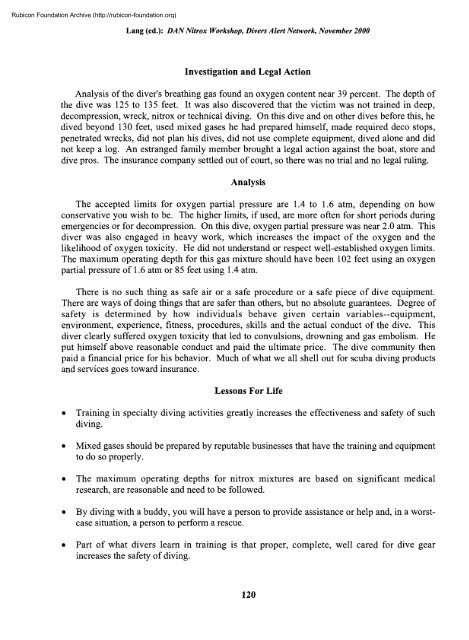Nitrox workshop dings - Divers Alert Network
Nitrox workshop dings - Divers Alert Network
Nitrox workshop dings - Divers Alert Network
Create successful ePaper yourself
Turn your PDF publications into a flip-book with our unique Google optimized e-Paper software.
Rubicon Foundation Archive (http://rubicon-foundation.org)Lang (ed.): DAN <strong>Nitrox</strong> Workshop, <strong>Divers</strong> <strong>Alert</strong> <strong>Network</strong>, November 2000Investigation and Legal ActionAnalysis of the diver's breathing gas found an oxygen content near 39 percent. The depth ofthe dive was 125 to 135 feet. It was also discovered that the victim was not trained in deep,decompression, wreck, nitrox or technical diving. On this dive and on other dives before this, hedived beyond 130 feet, used mixed gases he had prepared himself, made required deco stops,penetrated wrecks, did not plan his dives, did not use complete equipment, dived alone and didnot keep a log. An estranged family member brought a legal action against the boat, store anddive pros. The insurance company settled out of court, so there was no trial and no legal ruling.AnalysisThe accepted limits for oxygen partial pressure are 1.4 to 1.6 atm, depending on howconservative you wish to be. The higher limits, if used, are more often for short periods duringemergencies or for decompression. On this dive, oxygen partial pressure was near 2.0 atm. Thisdiver was also engaged in heavy work, which increases the impact of the oxygen and thelikelihood of oxygen toxicity. He did not understand or respect well-established oxygen limits.The maximum operating depth for this gas mixture should have been 102 feet using an oxygenpartial pressure of 1.6 atm or 85 feet using 1.4 atm.There is no such thing as safe air or a safe procedure or a safe piece of dive equipment.There are ways of doing things that are safer than others, but no absolute guarantees. Degree ofsafety is determined by how individuals behave given certain variables—equipment,environment, experience, fitness, procedures, skills and the actual conduct of the dive. Thisdiver clearly suffered oxygen toxicity that led to convulsions, drowning and gas embolism. Heput himself above reasonable conduct and paid the ultimate price. The dive community thenpaid a financial price for his behavior. Much of what we all shell out for scuba diving productsand services goes toward insurance.Lessons For Life• Training in specialty diving activities greatly increases the effectiveness and safety of suchdiving.• Mixed gases should be prepared by reputable businesses that have the training and equipmentto do so properly.• The maximum operating depths for nitrox mixtures are based on significant medicalresearch, are reasonable and need to be followed.• By diving with a buddy, you will have a person to provide assistance or help and, in a worstcasesituation, a person to perform a rescue.• Part of what divers learn in training is that proper, complete, well cared for dive gearincreases the safety of diving.120
















